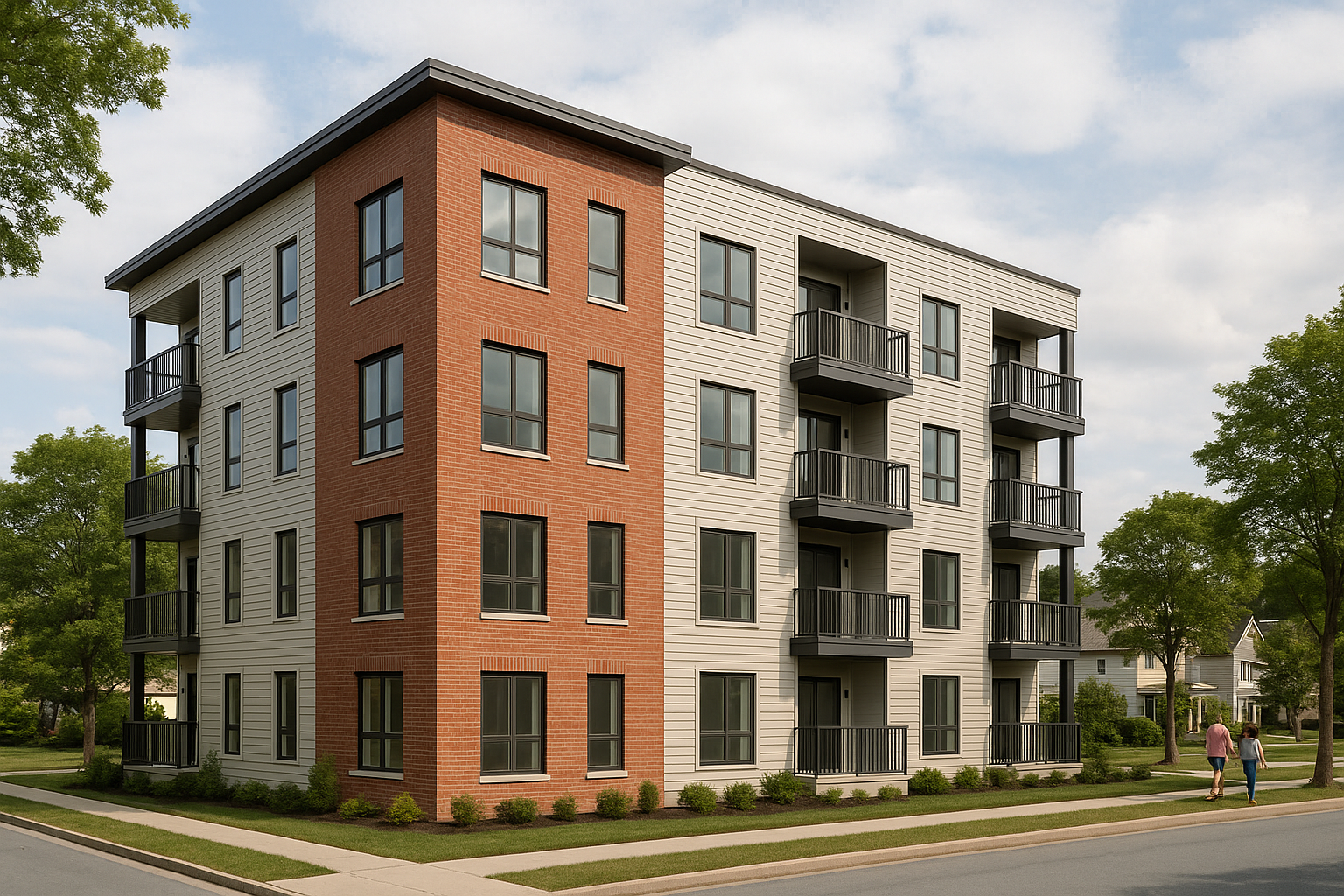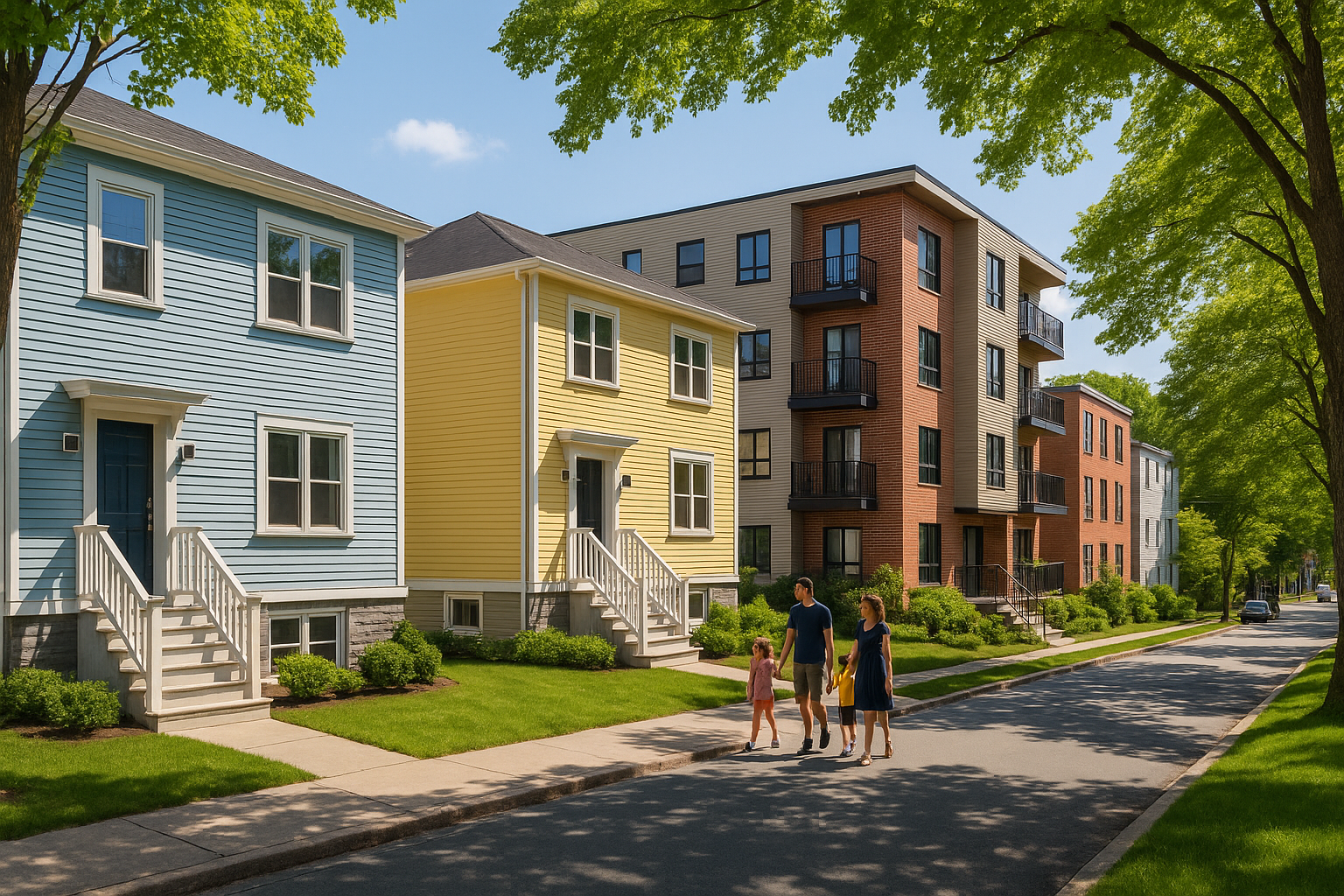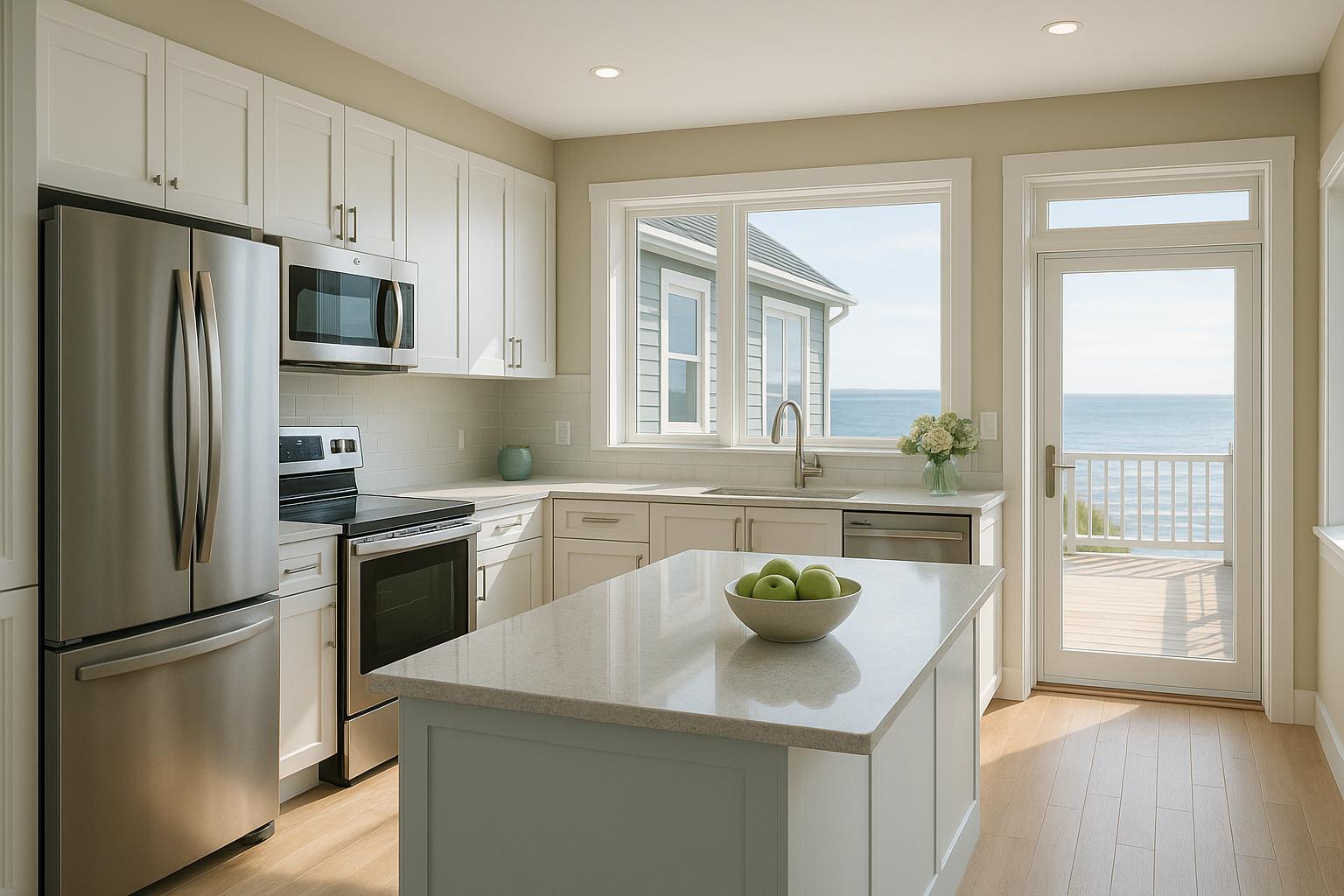ER-3 zoning in Halifax simplifies multi-unit residential development by allowing up to eight units per lot without rezoning. This zoning type supports diverse housing options like duplexes, townhomes, and small apartments, with lot size and frontage requirements dictating the number of units possible.
Key details:
- 4–8 units per lot based on size.
- No rezoning needed, saving time and effort.
- Lot requirements: Minimum 325 m² for 1–4 units.
- Flexible parking rules: No minimums required.
- Building height: Up to 12 metres (3 storeys).
- Cost per unit: ~$160,000, with rents ranging from $1,950–$2,100/month.
- ROI: Annual returns of 12–20%.
ER-3 zones are often located near transit, making them attractive for tenants. Construction can be streamlined with integrated design-build methods, reducing delays and costs.
For property owners, ER-3 zoning offers a straightforward way to develop rental properties while maximizing space and returns.
HALIFAX Home Owners May Have Just Won THE LOTTERY : Halifax Proposed Zoning Changes January 2024
Lot Size and Building Requirements
Understanding the minimum lot area and frontage rules in Halifax's ER-3 zones is essential for planning multi-unit developments. These regulations vary depending on the type of dwelling and are designed to maintain the character and scale of the neighbourhoods.
Minimum Lot Size and Frontage
Halifax's ER-3 zoning regulations outline specific requirements for lot size and frontage based on the type of dwelling being developed. Here's a breakdown:
| Dwelling Type | Minimum Lot Area | Minimum Lot Frontage |
|---|---|---|
| 1–4 unit dwellings | 325 sq. m. | 10.7 metres |
| Semi-detached dwelling | 230 sq. m. | 7.5 metres |
| Townhouse interior lot | 130 sq. m. | 6.1 metres |
| Townhouse end unit | 245 sq. m. | 9.1 metres |
These requirements help ensure that new developments align with the surrounding neighbourhood's layout and scale, promoting balanced growth.
Building Types and Unit Counts
Halifax's ER-3 zoning allows for a mix of single- and multi-unit developments, providing flexibility for various housing needs.
Building Types Allowed in ER-3 Zones
In ER-3 zones, you can develop single-family homes, duplexes, triplexes, and fourplexes. Among these, fourplexes are particularly popular because they fit neatly within the minimum lot area requirement of 325 square metres for buildings with 1–4 units. For townhouses, interior lots can be as small as 130 square metres, making it easier to increase unit density. These options give developers a range of possibilities to plan the best unit count and layout for their projects.
Standard Unit Count
A 325 square metre lot is often the go-to size for accommodating a fourplex without running into issues with municipal regulations. This lot size meets the necessary setback and parking requirements while also allowing for efficient use of space. Designing for four units on such a lot is a practical and common approach, as it balances functionality with compliance. The frontage, depth, and overall layout of the lot further shape how the building fits within the allowable envelope.
sbb-itb-16b8a48
Design and Municipal Requirements
Continuing from the earlier discussion on lot sizes and unit counts, this section outlines the design and municipal regulations that are crucial for ER-3 projects. Beyond adhering to guidelines on lot dimensions and unit numbers, ER-3 developments must follow specific rules to preserve the character of the neighbourhood.
Design Standards for ER-3 Buildings
Halifax's Centre Plan enforces design controls for multi-unit developments in ER-3 zones. Larger projects must meet minimum standards for window and wall articulation to ensure sufficient natural light and enhance the building's street presence. Entrances for individual units are required to face the street, promoting a pedestrian-friendly atmosphere.
Parking and Garbage Requirements
Parking rules for ER-3 developments have been significantly simplified. There are no minimum parking requirements for residential projects in these zones, aligning with the Centre Plan's goals to reduce car reliance and improve housing affordability.
"The Centre Plan has eliminated many of the minimum required parking spaces for a number of zones, and instituted maximum number of parking spaces for others." [3]
For projects that include parking, the focus shifts to quality over quantity. Parking spaces must be designed to be both visually appealing and safe.
"In the Centre Plan we moved away from parking minimums (we even included parking maximums for low density residential areas), and focused on making sure that parking, where it exists, is still designed to be attractive and safe." [4]
Garbage storage also has specific requirements. Buildings with 3–4 units must include a 1.2-metre garbage screening to enhance visual appeal. For projects with more than four units, stricter garbage storage rules apply.
Extra Requirements for 5+ Unit Buildings
Developments with five or more units are subject to additional design and compliance standards to ensure they blend well with the surrounding area. These projects must adhere to the following:
- Building dimensions are limited to 30 metres in depth and 20 metres in width [5].
- Parking cannot be located in the front yard and must be screened from neighbouring properties [5].
- Garbage storage must be confined to the back or rear yard with 1.8-metre-high screening [5].
- Ground floor balconies are not allowed, maintaining a consistent streetscape [5].
Meeting these extra requirements requires thoughtful planning from the start to ensure compliance without compromising the project's financial viability.
Maximizing Units and Investment Return
The number of units you build and how you approach the process can make or break your rental property’s profitability. Savvy property owners zero in on three main areas: picking the right lot, adopting a streamlined construction method, and understanding local financial conditions. Let’s dive into how selecting the right lot can elevate your investment returns.
Optimizing Lot Selection and Building Design
The success of any ER-3 project begins with choosing the right lot. ER-3 lots located on major transit corridors are ideal, as these areas are designed for higher density and have infrastructure already in place to support it[2][1].
Lot size plays a crucial role in determining building potential. Smaller lots - those under 325 m² - allow for a higher maximum lot coverage of up to 60%, compared to 50% for larger lots over 325 m²[6]. This difference could mean adding one or two extra units, which directly increases rental income.
Lot width is another key factor. Fire exit requirements and setback rules can eat into the buildable area, so wider lots often provide more flexibility for efficient unit layouts[6].
Pay attention to the Floor Area Ratio (FAR) as well. This regulation caps the total allowable building square footage, setting a hard limit on what you can construct, regardless of the lot’s size or height restrictions[6].
Don’t overlook parking regulations. Flexible parking requirements in ER-3 zones can free up valuable space, allowing for a larger building footprint or more units[1].
Integrated Design-Build vs Traditional Construction
Your choice of construction method can have a major impact on both costs and timelines. Traditional construction often requires juggling multiple contractors, while an integrated design-build approach consolidates all professionals under one roof.
| Aspect | Traditional Construction | Integrated Design-Build |
|---|---|---|
| Timeline | Typically 12–18 months | 6 months guaranteed |
| Cost Certainty | Cost-plus with 30–60% overruns | Fixed price set before construction |
| Coordination | Owner manages multiple contractors | Single point of accountability |
| Quality Control | Fragmented communication | Unified quality standards |
| Risk | Owner bears most risks | Builder guarantees timely delivery |
| Penalties | No penalties for delays | Up to $1,000/day for late completion |
The financial differences between these methods are striking. Traditional construction can lead to an average of $47,000 in coordination waste, not to mention delays that cut into rental income. By contrast, an integrated design-build approach eliminates much of this waste, streamlines communication, and ensures the project stays on track. These efficiencies translate into lower costs and a better return on investment.
Cost and ROI Numbers in Halifax
When you combine streamlined construction with Halifax’s local market conditions, the investment potential in ER-3 zones becomes clear. Standard ER-3 builds cost around CAD$160,000 per unit. Two-bedroom units in these areas typically rent for CAD$1,950–2,100 per month, offering annual returns between 12–20%.
For projects qualifying under CMHC MLI Select, the costs rise to CAD$200,000 per unit. However, these projects come with 95% financing, 5% down payments, and 50-year amortizations, making it possible to achieve positive cash flow from day one despite the higher upfront costs.
To make an ER-3 project financially viable, you’ll need a minimum of four units. This translates to a total investment of roughly CAD$640,000 for standard builds or CAD$800,000 for CMHC MLI Select projects. For an extra CAD$15,000 per unit, you can opt for a Premium Rental Ready Package, which includes Energy Star appliances and smart home features. This package enables immediate rent collection, skipping the typical furnishing period.
With controlled construction costs, strong rental demand, and favourable financing options, ER-3 zoning in Halifax offers an appealing opportunity for property owners to maximize their returns in a competitive market.
Key Points for ER-3 Property Owners
Halifax's ER-3 zoning offers property owners a straightforward way to generate rental income without the hassle of rezoning. With the ability to develop up to eight units per lot - whether as duplexes, townhomes, small apartments, or condos - it’s one of the most adaptable residential zones in the city [1][6].
Construction costs average around CAD$160,000 per unit, and with rental rates ranging between CAD$1,950 and CAD$2,100 per month, investors can see annual returns of 12–20%. A typical project begins with a minimum of four units, requiring an initial construction investment of approximately CAD$640,000.
The location of ER-3 zones adds another layer of appeal. These areas are situated along transit corridors and within well-established neighbourhoods, which not only enhances occupancy rates but also allows for higher rental pricing [2][1].
Another advantage is the removal of minimum parking requirements. This change frees up more space on your lot, enabling additional units or larger living areas instead of dedicating land for parking [1].
Design flexibility is a standout feature. With allowances for building heights up to 12 metres and lot coverage of 50–60%, you can make the most of your property’s footprint. These generous allowances simplify the design process and create opportunities for efficient construction [1][6].
Traditional construction often comes with risks like 30–60% cost overruns and delays of 8–18 months. However, using an integrated design-build approach can save approximately CAD$47,000 in coordination costs while ensuring fixed pricing and on-time delivery. This approach minimizes risks and keeps your project on track.
FAQs
What are the advantages of using an integrated design-build approach for ER-3 multi-unit projects in Halifax?
An integrated design-build approach brings several advantages for ER-3 multi-unit projects in Halifax. By merging the design and construction stages, this method significantly speeds up project timelines - sometimes completing construction in just six months, compared to the usual 12 to 18 months.
This method also encourages smoother collaboration among designers, builders, and property owners. With everyone on the same page, miscommunication is minimized, helping to avoid costly mistakes or delays. Plus, having a single point of accountability means property owners enjoy more predictable costs, fewer unexpected issues, and a quicker path to getting units ready for tenants. It’s an efficient way to tackle small multi-unit developments while staying within Halifax’s zoning requirements.
How do parking requirements in ER-3 zones affect the design and profitability of multi-unit developments?
In Halifax's ER-3 zones, parking requirements are more relaxed - there are no mandatory minimums for parking spaces. This gives property owners the freedom to design layouts that make better use of land, accommodate more units, and potentially increase rental income.
Without strict parking mandates, developers can come up with creative, budget-friendly parking solutions that fit the overall vision of their project. When done right, this approach can lower construction costs, enhance profitability, and still meet the needs of tenants.
What should I consider when choosing an ER-3 zoned lot in Halifax to optimize unit density and investment potential?
When choosing an ER-3 zoned lot in Halifax, there are several critical aspects to keep in mind. Lot size is one of the most important, typically ranging from 375 to over 600 m². This size can support anywhere from 4 to 8 units, depending on the lot's shape and layout. Another key consideration is lot coverage, which generally falls between 40% and 60%. Additionally, setbacks - such as 6 metres for both the front and rear, and 1.2 metres on the sides - directly influence the buildable area.
Beyond the physical dimensions, you’ll want to think about the lot’s proximity to transportation links, which can enhance accessibility and appeal for tenants. Meeting the minimum lot area requirements is also crucial, particularly if your goal is to increase density and boost rental income. By thoroughly assessing these elements, you can make well-informed decisions that align with Halifax’s ER-3 zoning rules and optimize your investment potential.



